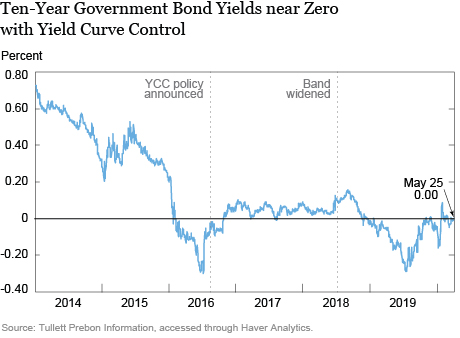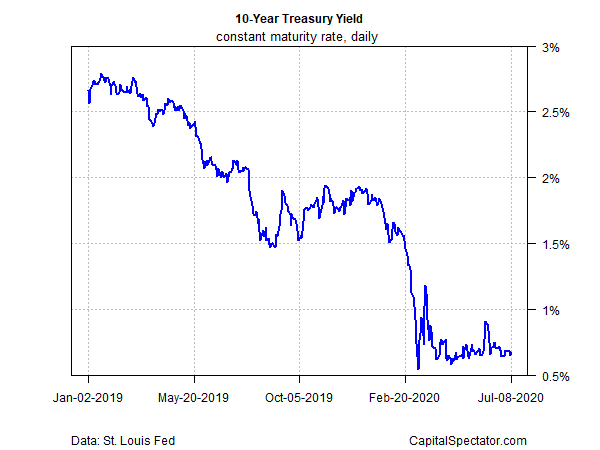The Federal Reserve has publicly disclosed it’s considering it and many commentators have analyzed the implications. Officially, the central bank is conducting “further analysis” on so-called yield curve control (YCC). But looking at the flat trend in the 10-year Treasury yield in recent months raises the obvious question: Has YCC already started?
For the uninitiated, YCC is a commitment by a central bank to buy a sufficient quantity of long-term bonds to keep the rate from rising above a specific target yield. The goal: stimulate the economy by suppressing interest rates to levels below levels favored by the market.
As a policy tool, YCC is an alternative to quantitative easing (QE), which has prevailed for much of the past decade-plus. Whereas QE (a type of unconventional monetary policy) uses newly printed money as a broad-brush strategy to buy government bonds and other assets, YCC focuses on explicitly managing specific interest rates with asset purchases and sales.
Why shift to YCC from QE? One school of thought argues that with interest rates close to zero—again—YCC is a more effective tool for juicing the economy compared with QE.

Four years on, what’s the verdict? On the goal of lifting inflation (Japan has long suffered from persistent disinflation/deflation) there’s not much progress. Core inflation in Japan is more unless unchanged at roughly 0.5% — in line with the pace when YCC was implemented. The optimistic spin: core inflation might have fallen further without YCC. Maybe, but a counterfactual is difficult to prove – especially in macroeconomics — and so the jury remains out on this front.
As for the real economy, that’s a gray area too. Japan’s pre-pandemic output via the rolling 1-year GDP trend picked up moderately after YCC was implemented in 2016. Yet the pickup in growth was in line with pre-2016 accelerations and so it’s unclear how much YCC contributed to the change.
For the US, the Federal Reserve in its June 9-10 minutes noted that “all participants agreed that it would be useful for the staff to conduct further analysis of the design and implementation of YCT [yield caps or targets] policies as well as of their likely economic and financial effects.”
Formally, the Fed isn’t targeting yields, although the recent flat-lining of the 10-year yield suggests otherwise. With a few exceptions, the 10-year rate has been unusually stable since April, holding in a tight 0.6%-0.7% range except for one short-lived spike to 0.91%.

Coincidence? Maybe, although with the growing focus on YCC in the US it’s reasonable to wonder if the Fed is testing the policy without formally announcing it and whether the market is now pricing in its own version of YCC as a forgone conclusion.
Regardless, the case for YCC is building, according to a number of analysts. For example, veteran Fed watcher Tim Duy (an economist at the University of Oregon) expects that any doubts at the Fed about YCC “will eventually fade.” Why? As he explains on Fed Watch blog: “My position assumes continued economic weakness, inflation persistently below target, and an eventual unwillingness on the part of the Fed to continuously ramp up the scale of asset purchases” via QE.
He adds that “With a new wave of Covid-19 cases sweeping some states, particularly in the South and West, it is becoming increasingly evident that we will not experience anything like a V-shaped recovery.”
Ed Al-Hussainy, senior interest rate and currency analyst at Columbia Threadneedle Investments, also sees a growing case for capping yields. “I expect YCC to be an active part of the Fed’s toolkit on two fronts,” he told The Bond Buyer last month. First, “as a way to cement forward guidance on the front end of the curve and provide the Treasury an incentive to skew issuance towards bills/short-term notes in funding the 2020-21 deficits,” and secondly, “as an option to cap long end yields in the event of a disorderly steepening of the Treasury curve.”
There are many skeptics of YCC, including members of the Fed’s monetary policy committee. And by some accounts, the need for capping yields in the US is redundant as long as rates stay low.
The question is whether the debate has become moot? Jon Hill, US rates strategist at BMO Capital Markets, says the increased focus on YCC in recent months has “basically meant that the Fed has already accidentally implemented it.”
